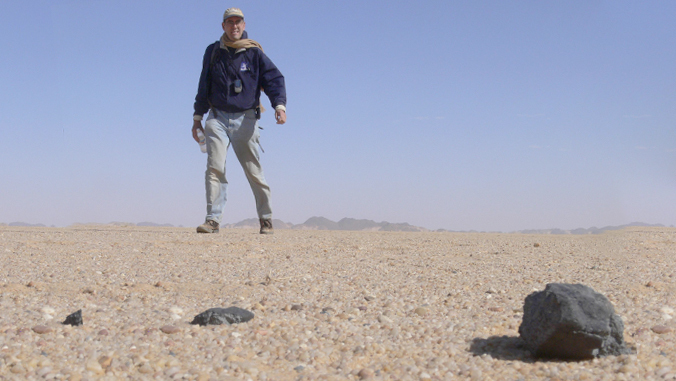Despite viral story, UH did not find THC on a meteorite
The University of Hawaii is the target of a “fake news†article making rounds on social media, and UH experts say there are many lessons to learn.
The article, which was first posted in 2015 and recently went viral, claims that UH astrophysicists discovered Tetrahydrocannabinol (THC) on a meteorite found in the Nevada desert in 2010. THC is a chemical found in marijuana. The article includes false quotes by a made up astrophysicist who never worked at UH.
After the story was shared thousands of times on social media, USA Today reached out to UH to confirm if the astrophysicist actually worked at the university, and debunked the original story in a recent post.
Growing problem of ‘fake news’
Associate Professor Colin Moore, UH MÄnoa Public Policy Center director and School of Communications chair in the College of Social Sciences, said the proliferation of “fake news†carries two major problems.
“The first and most dangerous is that it reduces trust in all information sources, which can lead people to consume less news overall,†Moore said. “This leads to the second problem. As people are less willing to consume news from a wide variety of sources, they may only pay attention to sources that confirm their preexisting beliefs, which contributes to further political polarization.â€
School of Communications Assistant Professor Julien Gorbach published an article in American Journalism in 2018 called “Not Your Grandpa’s Hoax: A Comparative History of Fake News.†In it, he recalls how the term “fake news†gained traction during the 2016 presidential election. Gorbach, however, said that “fake news†has been around for several decades, with different motivations behind creating these stories.
“There’s fake stories or false stories that are done for fun or satirical reasons. There’s often a strong motivation for profit—if you can introduce the right kind of ‘fake news’ story, it goes viral. Even before the internet, it can still go viral—you just have everybody rushing to the newsstands,†Gorbach said. “There’s stuff that’s done for profit that’s deliberately deceptive and then there are other agendas including political agendas or ideological agendas.â€
Responsibility of filtering out false stories
Moore said that while technology companies such as Facebook bear much of the responsibility when it comes to filtering out “fake news,†readers also have a responsibility of deciphering credible information.
“There are ways to automate this process and flag stories that are known to be false. Crowdsourcing the detection of fake stories can also help. Ultimately, more and more companies and educational institutions will need to devote resources to finding and removing these stories,†Moore said. “People should not be shy about calling out fake news on their social media feeds. We also need to find more ways to support real journalism. One of the best ways to defeat fake news is to build bigger audiences for high-quality news outlets.â€
Gorbach added, “With stories like this, what a lot of them do highlight is the idea that with the internet, the gatekeepers went away. Before the internet, most people got their information through newspapers, books or through the broadcast networks so there were all of these gatekeepers of editors, book publishers and broadcast producers who would filter out what they thought was legitimate information. What the internet did was put the responsibility of doing that gatekeeping on every individual consumer.â€
News literacy at UH MÄnoa
Gorbach teaches JOUR 150: Journalism and Society at UH MÄnoa, which focuses on news literacy.
“It’s very challenging because as the technology advances and as our politics has become increasingly divisive and toxic, the tactics for disinformation are advancing faster than our ability to teach how to dismantle them,†Gorbach said.
Gorbach said the faculty emphasize two methods for checking facts. The first is a checklist of criteria that news consumers can use to evaluate sources within a given story. These criteria are abbreviated by the acronym “IM VAIN.“ The questions include: are the sources in the story independent? multiple? verified? authoritative? informed? and named? The second is “reading laterally,†which is described by Moore.
“The easiest way to avoid this is by cross-checking your sources,†Moore said. “If there are no other credible news sites reporting a similar story, then you should be skeptical. Readers can also investigate the news outlet and author. It’s important to know who’s funding the news website and what other articles the author has written. Even the layout of the news website can provide clues. If it’s full of sensationalist headlines, grammatical errors, and generic images, then I would be very cautious.â€
This work is an example of UH MÄnoa’s goal of Excellence in Research: Advancing the Research and Creative Work Enterprise (PDF), one of four goals identified in the 2015–25 Strategic Plan (PDF), updated in December 2020.


